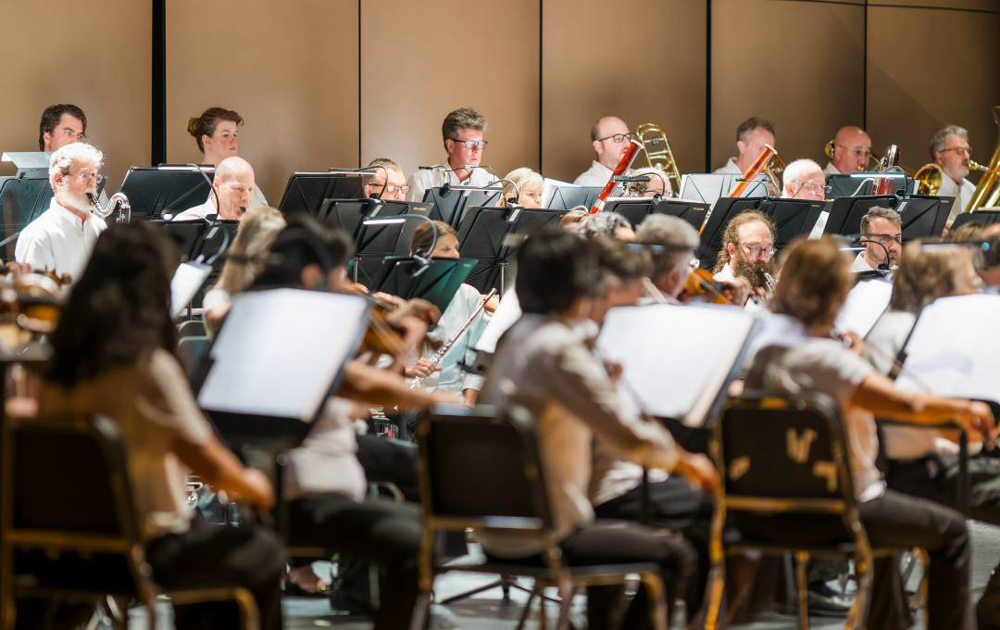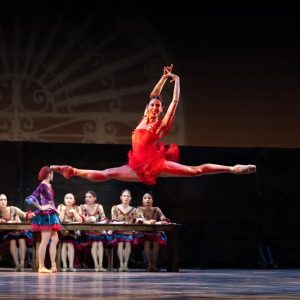By Denny Dyroff, Entertainment Editor, The Times

Brandywine Valley Symphony
The Brandywine Valley Symphony will present its debut concert on October 12 in the Duffy Arts Center of Malvern Preparatory School (418 South Warren Avenue, Malvern, bvsymphony.org) and Chester County will be in its DNA.
Actually, the concert is a debut in name only — because of the orchestra’s new name.
A few months ago, the orchestra performed its final concert as the Kennett Symphony with an outdoor show at Longwood Gardens in Kennett Square.
This weekend’s concert will mark the beginning of the orchestra’s 85th season.
The orchestra is moving into its next phase in style by performing a popular piece by West Chester’s internationally acclaimed composer Samuel Barber.
The first concert of the season is “Masterworks 1: Where the River Meets the Sky” in the Duffy Arts Center of Malvern Preparatory School.
With its Georgian Revival design and state-of-the-art 600-seat theater, the Duffy Arts Center is magnificent in both architecture and acoustics, providing an ideal setting for the Symphony’s first performance at this venue.
The program features Barber’s “Essay No. 1,” Edvard Grieg’s “Piano Concerto in A minor” with guest pianist Anna Shelest, and Robert Schumann’s “Symphony No. 3 — Rhenish.”
Barber was an American composer, pianist, conductor, baritone, and music educator — and one of the most celebrated composers of the mid-20th century.
Principally influenced by nine years of composition studies with Rosario Scalero at the Curtis Institute and more than 25 years of study with his uncle, the composer Sidney Homer, Barber’s music was influenced by traditional 19th-century harmonic language and formal structure embracing lyricism and emotional expression.
However, he adopted elements of modernism after 1940 in some of his compositions, such as an increased use of dissonance and chromaticism in the “Cello Concerto” (1945) and “Medea’s Dance of Vengeance” (1955).
Barber was adept at both instrumental and vocal music. His works became successful on the international stage and many of his compositions enjoyed rapid adoption into the classical performance canon.
He received the Pulitzer Prize for Music twice — for his opera “Vanessa” (1956–1957) and for the “Concerto for Piano and Orchestra” (1962).
Barber was born in West Chester, the son of Marguerite McLeod (née Beatty) and Samuel Le Roy Barber. He was born into a comfortable, educated, social, and distinguished American family.
His father was a physician, and his mother was a pianist of English-Scottish-Irish descent.
His maternal aunt, Louise Homer, was a leading contralto at the Metropolitan Opera. His uncle, Sidney Homer, was a composer of American art songs.
A child prodigy, Barber became profoundly interested in music at a very young age, and it was apparent that he had great musical talent and ability.
He began studying the piano at the age of six and at age seven composed his first work, “Sadness,” a 23-measure solo piano piece in C minor.
At the age of 10, Barber wrote his first operetta, “The Rose Tree,” to a libretto by the family’s cook. At the age of 12, he became an organist at a local church.
At the age of 14, Barber entered the youth artist program at the Curtis Institute of Music in Philadelphia, where he ultimately spent 10 years developing his talents as a triple prodigy in composition, voice, and piano.
During his initial studies at Curtis, he simultaneously attended and graduated from West Chester High School (later West Chester Henderson High School), during which time he composed his school’s alma mater which is still in use.
After an illustrious career which spanned more than a half-century, Barber’s time ran out.
Barber was hospitalized on and off between 1978 and 1981 while undergoing treatment for cancer. He died of the disease in January 1981 at his apartment in Manhattan at the age of 70.
The funeral was held at the First Presbyterian Church of West Chester three days later and he was buried in the Oaklands Cemetery, which is located at 1042 Pottstown Pike.
On Sunday, the Brandywine Valley Symphony will bring Barber’s music to life when it performs his “Essay No. 1.”
Barber’s “Essay for Orchestra” resembles but is not equivalent to a first movement of a symphony. It was written in 1937, ostensibly at the behest of Arturo Toscanini, and given its premiere the following year, along with Barber’s “Adagio for Strings.”
The musical “essay,” a form of Barber’s own rather clever invention and one with which he had some previous success over a decade earlier in his “Three Essays for Piano,” is a medium much like its more familiar literary counterpart.
As with a written essay, the idea behind a musical essay is the development of a complex, well-reasoned, thoughtful work drawn from a single melodic thesis.
The idea behind “Essay No. 1” is a mysterious and understated theme, initially presented by the string section. This is followed by a more dramatic section largely dominated by woodwind, strings and piano, culminating in a powerful return to the original theme before the music ebbs away.
Another composition to be featured in Sunday’s concert will be Edvard Grieg’s “Piano Concerto in A minor” with pianist Anna Shelest as soloist.
The “Piano Concerto in A minor, Op. 16,” composed by Grieg in 1868, was the only concerto Grieg completed.
It is one of his most popular works and is among the most popular of the genre. Grieg was only 24 years old at the time of the composition.
Grieg scored the concerto for solo piano, two flutes, two oboes, two clarinets, two bassoons, four horns, two trumpets, three trombones, timpani and strings (violins, violas, cellos and double basses).
Grieg’s beloved Piano Concerto was the product of a particularly happy period in the Norwegian composer’s life.
A native of Ukraine, Anna Shelest received her early music education at the Kharkiv Special Music School. She received her master’s degree from The Juilliard School in New York City, where she studied with Jerome Lowenthal.
Hailed as the “female reincarnation of Liszt” and “a piano lioness,” she has since performed throughout the world as both a soloist and chamber musician, including appearances with the Cincinnati, Montreal, and Netherlands Symphony Orchestras, as well as the St. Petersburg Philharmonic.
Schumann’s “Symphony No. 3”, also known as the Rhenish, is the last symphony composed by the German pianist/composer. It premiered in February 1851 in Düsseldorf — conducted by Schumann himself.
The symphony as a whole captures Schumann’s response to the Rhineland at its most euphoric. The whole symphony was sketched and orchestrated in a mere five weeks.
There are two forces at work in the Symphony – an essential formal conservatism and an exuberant rhythmic and melodic inventiveness.
These three compositions will mark the maiden voyage for the newly named symphony.
Kennett Symphony, which began in 1940 as a small volunteer community orchestra in Kennett Square, has evolved a lot over the last eight decades and had two other monikers – Kennett Symphony Orchestra and Kennett Symphony of Chester County.
The ensemble has steadily grown by using professional musicians and talented conductors. The Symphony embraces its proud legacy of presenting timeless classics to audiences in the suburbs of Philadelphia, Main Line, and Chester County.
From 1988-2013, the orchestra, which then was known as the Kennett Symphony of Chester County, blossomed under the leadership of Mary Woodmansee Green, Pennsylvania’s first woman to be appointed conductor of a professional symphony.
When Green retired, she was succeeded by current Artistic Director Michael Hall.
The 2025–2026 season features one special event, one salon concert with food and spirits, three full-orchestra Masterworks concerts, and three chamber music performances highlighting brass, woodwind, and string ensembles.
According to Hall, “Our orchestra continues to thrive, deepening its artistic excellence while strengthening connections throughout the Brandywine Valley.
“This season honors the great symphonic tradition while embracing new perspectives and innovative experiences. From the intimacy of chamber concerts to the grandeur of our season finale beneath the stars at Longwood Gardens, we welcome audiences of all ages to experience the power, beauty, and inspiration of live orchestral music.”
The new BVS season continues next month.
On November 23 at 3 p.m., the Salon Concert in the Grand Ballroom of Mendenhall Inn in Chadds Ford offers an intimate and immersive experience.
It features Tchaikovsky’s “Serenade for Strings,” light appetizers, and drinks. The performance is hosted by Michael Hall with stories, musical examples, and multimedia projections that bring the work to life. Tickets include hors d’oeuvres and a beverage, with a cash bar available.
The Holiday Concert with the BVS Brass Quintet is scheduled for December 6 at 6:30 p.m. at the Chester County History Center in West Chester.
Surrounded by over 300 years of history, audiences will enjoy arrangements celebrating the holidays with the joyful sounds of carols and festive classics.
The 2026 portion of the 2025/2026 season includes the Family Concert with the BVS Woodwind Quintet on February 28,
“Masterworks 2: Songs Without Borders” on March 22 at the Uptown Knauer Performing Arts Center in West Chester, the Mother’s Day Concert with the BVS String Quartet on May 9 in the Copeland Lecture Hall at Winterthur Museum, Garden & Library and “Masterworks 3: Made in America” on June 25 in the Open Air Theatre at Longwood Gardens.
Video link for Samuel Barber — https://youtu.be/QOYx8HetpH4.
Video link for Brandywine Valley Symphony — https://youtu.be/7Jbrh567kFI.
The concert on October 12 will start at 3 p.m.
Tickets, which are $65 for adults and $20 for students and children, include a pre-concert talk and a post-concert Q&A with the conductor, soloist, and musicians.
Two very well-known – and very popular – classical pieces will also be featured at shows in Philly this weekend by one of the nation’s premier ballet companies.

Philadelphia Ballet
Now through October 12, the Philadelphia Ballet is presenting performances of “Boléro” and “Carmen” at the Academy of Music (Broad and Locust streets, Philadelphia, 215-893-1999, www.philadelphiaballet.org).
The ballet pieces are set to music that has become familiar to even those who are unfamiliar with classical music – especially because of their use in movie soundtracks.
“Boléro” is a 1928 work for large orchestra by French composer Maurice Ravel. It is one of Ravel’s most famous compositions.
It is usually played as a purely orchestral work, only rarely staged as a ballet.
“Boléro” gained international attention after it featured prominently in the 1979 romantic comedy “10,” costarring Dudley Moore and Bo Derek.
The other familiar piece is “Carmen.”
“Carmen” is an opera in four acts by the French composer Georges Bizet. The opera was first performed by the Opéra-Comique in Paris in 1875, where its breaking of conventions shocked and scandalized its first audiences.
“Carmen” has since become one of the most popular and frequently performed operas in the classical canon; the “Habanera” and “Seguidilla” from Act 1 and the “Toreador Song” from Act 2 are among the best known of all operatic arias.
The opera is written in the genre of opéra comique with musical numbers separated by dialogue. It tells the story of the downfall of Don José, a naïve soldier who is seduced by the wiles of the fiery gypsy Carmen.
The Philadelphia Ballet translates the music into flowing movement.
The ballets are performed under the guidance of artistic director Angel Corella. The ballet is based on the choreography of George Balanchine.
Born in Madrid, Spain, Corella joined American Ballet Theatre in 1995 and was quickly promoted to principal dancer. In his 17-year career with ABT, he established himself as one of the greatest male dancers of his time.
Corella has also appeared as a guest artist with the Royal Ballet in London, the Kirov Ballet in Russia, and New York City Ballet. From 2008-2014, he served as director for his own company, the Barcelona Ballet.
Philadelphia Ballet’s “Carmen” is a raw and riveting exploration of desire, freedom, and betrayal, brought to life through the power and intensity of the dancers, and set to Georges Bizet’s iconic operatic score.
With “Boléro,” the ballet’s daring feats of athleticism entrance audiences with deliberate, percussive movements that build in a performance-long crescendo.
Video link for Philadelphia Ballet — www.facebook.com/reel/775813261993681.
Performances are October 9 and 10 at 7:30 p.m., October 11 at noon and 6 p.m. and October 12 at 2 and 7 p.m.
Ticket prices start at $62.
This should have been the penultimate weekend for the current run of the World Premiere of Kathryn Grody’s “The Unexpected 3rd: A Radical, Rollicking Rumination on the Optimism of Staying Alive” – but the show’s run has been extended.
“The Unexpected 3rd: A Radical, Rollicking Rumination on the Optimism of Staying Alive” is now running through October 26 at People’s Light (39 Conestoga Road, Malvern, www.peopleslight.org).
The Obie-winning artist’s solo show explores getting old, dealing with identity and reinvention with fierce humor and radical honesty.
This raw, poetic and darkly funny show invites audiences into Grody’s intimate reflections on aging, identity and staying true to one’s self — no matter what the world expects of you.
Following sold-out readings at the 2024 Kiln New Works Festival at People’s Light, “The Unexpected 3rd” returns to the theatre that helped spark its development, now taking center stage as the season opener.
According to Grody, “The transition into elderhood is not just bewildering but equal parts empowering, mysterious and absurd. “This show is about living truthfully, unapologetically and with unyielding curiosity at 78 and beyond. It feels especially right to debut it at People’s Light, a place that embraces honesty, complexity and the full spectrum of being human.”
Directed by acclaimed regional theatre director and Grody’s longtime friend and collaborator Timothy Near, the production playfully blurs the line between personal monologue and theatrical memoir, inviting audiences of all generations to reflect on what it means to grow older in a culture obsessed with staying young.
At its core, “The Unexpected 3rd” is a dynamic and real-time contemplation of a universal question: What happens when you’re no longer who you were but not yet someone else?
“The Unexpected 3rd” through October 26 on the Steinbright Stage at People’s Light.
Ticket prices start at $35.
The Candlelight Theatre (2208 Millers Road, Arden, Delaware, candlelighttheatredelaware.org) is presenting “Ragtime: The Musical” now through October 26.
“Ragtime” blends fictional narratives with authentic historical figures and events.
The story focuses on Coalhouse Walker, Jr., — and his beloved Sarah. Walker is a Black pianist who buys a Model T Ford and sets off a series of events that span all levels of New York City society
It also features magician Harry Houdini, industrialist Henry Ford, celebrity party girl Evelyn Nesbit, civil rights leader Booker T. Washington, architect Stanford White, anarchist Emma Goldman, a wealthy white family living in suburban New Rochelle led by matriarch Mother and Tateh (a Jewish Latvian immigrant who becomes a movie director) and his little girl.
The show explores themes of racism, injustice, hope, and dreams amid the changes in society, music, and culture rising in New York City — and across America.
Three social castes in turn-of-the-century New York introduce themselves to the audience.
The first is an upper-class white family from New Rochelle — the Little Boy (Edgar), his Father (who runs a fireworks factory), Mother, Mother’s Younger Brother, and Grandfather. They live a genteel life and enjoy a lack of racial and ethnic diversity.
The second is the Black residents of Harlem, including a beautiful young woman named Sarah, who adores the pianist Coalhouse Walker Jr.
The third are immigrants from Europe on the Lower East Side, among them “Tateh,” a Jewish artist from the Baltic states and his young daughter.
These three worlds are connected by narration from the luminaries — J. P. Morgan, Henry Ford, Booker T. Washington, Emma Goldman, Harry Houdini, and Evelyn Nesbit.
Even though “Ragtime” is set in the early 20th century, it shares troubling topics with today’s world – stifling prejudice, xenophobia and unrelenting racism.
The show will run now through October 26.
Tickets, which include pre-show dinner and free parking, are $75.50 for adults, $35 for children (ages 4-12) and $35 for “Show Only.”
Dinner and Show times: Thursday, Friday and Saturday performances, 6 p.m. for meal and 8 p.m. for show; Sunday Matinees, 1 p.m. for meal and 3 p.m. for show; Wednesday Matinees, 11 a.m. for meal and 1 p.m. for show.
Candlelight’s Quizzo Night is scheduled for October 20 and the monthly Candlelight Comedy Club will be held on October 23 with Dennis Rooney and Lori Palminteri.
Kennett Flash (102 Sycamore Alley, Kennett Square, 484-732-8295, http://www.kennettflash.org) is hosting Antje Duvekot and Seth Glier on October 9 and Open Mic Night on October 11.
On October 3, Uptown! Knauer Performing Arts Center (226 North High Street, West Chester, www.uptownwestchester.org) will present Theatre Rock Live on October 10 and The Drifters on October 12.
Jamey’s House of Music (32 South Lansdowne Avenue, Lansdowne, 215-477-9985, www.jameyshouseofmusic.com) will have Kate Gaffney’s Corner featuring Larkspur Gunther on October 9, The Boneshakers and GeminiDrag on October 10 and the Girke-Davis Project on October 12.
Jamey’s will also present the Philadelphia Blues Society 2025 Blues Festival at Temple University’s Ambler Campus on October 11 with Danielle Miraglia, The Philly Blues Kings with Clarence Spady and Kate Gaffney, Erin Harpe & Jim Countryman, Billy the Kid and The Regulators, The Mikey Junior Band and Solomon Hicks.
Elkton Music Hall (107 North Street, Elkton, Maryland, www.elktonmusichall.com) will have The Tommy Dorsey Orchestra on October 9, The Collingwood on October 10, Chris Knight Band on October 11 and Pokey LaFarge & His Band on October 15.




